October 2–7, 1918
On October 2 the 77th Division, attacking northward in the Argonne Forest as the left division of the I Corps and American First Army, encountered heavy resistance and made little progress except in the zone of action of the 308th Infantry.
Six companies of that regiment and parts of two companies of the 306th Machine Gun Battalion, which were operating under orders to proceed without regard to the progress on their flanks, penetrated the enemy lines by following a small valley and established themselves, just before dark, on the northern slope of the ravine to the east of Charlevaux Mill. (See map page 363.) Communication had been maintained with the troops in rear during the day, and late in the evening one company of the 307th Infantry succeeded in moving forward to join this advanced force in the ravine.
The Germans, however, pushed troops between the main body of the division and these companies, with the result that by daybreak on October 3 the companies were completely surrounded.
This little force, holding a position about ½ mile in advance of the front line of the division, was subjected to repeated assaults and exposed to incessant machine-gun and minenwerfer fire from all sides. Food was exhausted on the second day, water could be procured only with difficulty from the muddy creek, which was exposed to hostile fire, and suffering from hunger and thirst became more and more acute. Ammunition soon became scarce and to defend themselves the men in the position were forced to salvage rifles and ammunition from the German dead.
The Air Service did not succeed in its attempts to deliver messages or to drop food, medical supplies and ammunition into the position, and the efforts of the 77th Division to push forward to relieve its isolated troops were also unsuccessful. Disdaining any thought of surrender, however, the detachment maintained its unequal fight day and night.
Finally, on October 7, the right of the American I Corps launched an attack from the east against the flank and rear of the hostile position in the Argonne Forest and at the same time the 77th Division renewed its attacks.
This flanking movement forced the Germans to withdraw, and that evening the troops of the 77th Division advancing from the south rescued the “Lost Battalion,” which that afternoon had beaten off the last and fiercest attack against it.
When relieved on the night of October 7, after having been cut off for five days and nights, only about one third of the more than 600 men who had entered the position were able to walk from it.
The American First Army at the time this operation started was engaged in the Meuse-Argonne offensive and, in the Argonne Forest, was facing the German second position, a strongly organized defensive line. The “Lost Battalion” penetrated that line at a place temporarily unoccupied by German troops. When reoccupied by the Germans the defenses were so strong that, in spite of the greatest efforts, the 77th Division could not break through until the flank attack of the I Corps forced the enemy to retire.
In 1927 the American Battle Monuments Commission published “A Guide to the American Battle Fields in Europe”to commemorate the tenth anniversary of America’s entrance into the war. One of the early authors assigned to the commission to continue this work was Maj. Dwight D. Eisenhower.
By 1938 the American Battle Monuments Commission had expanded its guidebook, both to provide visitors with a detailed, documented itinerary for visits and to serve as a history of the American Expeditionary Force’s accomplishments.
Through that guide we’ll have a look at a forgotten act of WW1
This tour begins at Reims and ends at Charlevaux Mill near Binarville. It is 58 miles (97kilometers) long.
The mileage figures in the text are given merely as an aid to the reader and are not essential in following the itinerary.
When following the described route, unless contrary road instructions are specifically given, continue straight ahead.
Speedometer distance is measured from the statue of Joan of Arc which is located on the plaza in front of the cathedral.
(0 m 0.0 km) With automobile facing cathedral, set speedometer to read zero. Leave plaza by street to the right front and follow the route to the exit of town shown on the following sketch.
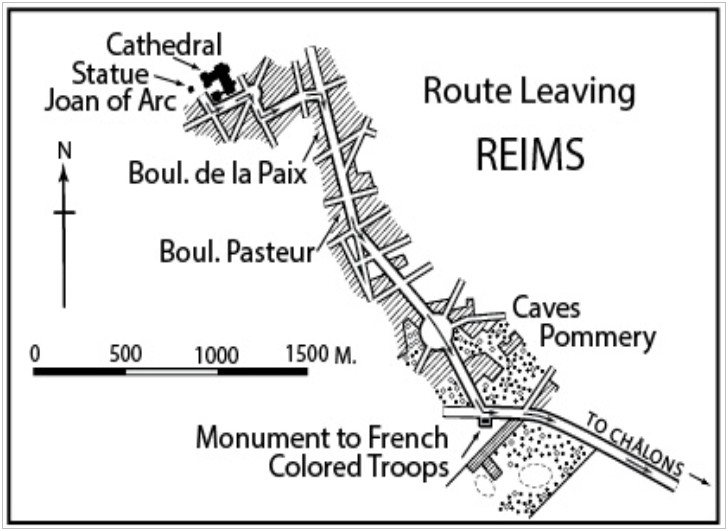
(1.5 m 2.4 km) Near edge of town, at road junction where street ends, is located a small monument to the colored troops who fought in the French Armies.
(4.3 m 6.9 km) Beyond town, after crossing railroad, on the sky line just to the right of the road ahead are seen the battered ruins of the Fort de la Pompelle, a French fort built many years before the World War for the defense of Reims. It was captured by the Germans early in September 1914 and recaptured by the French soon thereafter. During the fighting in 1918 it was encircled by the German troops but not captured. Severe fighting took place all around it.
Across the road from the fort is a monument to the defenders of this part of the front during the World War.
At road junction near fort, close to the right side of the road, is one of a number of small markers erected at various points along the roads of France and Belgium to indicate the line from which the German forces were hurled back by the Allied Armies in the summer and fall of 1918.
And we keep going towards theSouain’s area where elements of the American 42d Division fought and continue through St. Hilaire-le-Grand, and Sommepy.
On the Binarville – Apremont road
(57.9 m 93.2 km) Some distance farther on, while descending steep hill, to the right along the bank can be seen (1937) several entrances to former German shelters and dugouts.
(58.2 m 93.7 km) At foot of hill, the pond crossed is that of Charlevaux Mill. During the war that part of it to the right of the road did not exist.
(58.3 m 93.8 km) Beyond the bridge, to the right across the valley is soon seen the small ravine by means of which the troops of the “Lost Battalion” advanced to this vicinity on October 2.
(58.6 m 94.3 km) Just beyond the first LEFT bend in the road, at the small stone marked “Lost Battalion,” located near the right edge of the road, STOP.
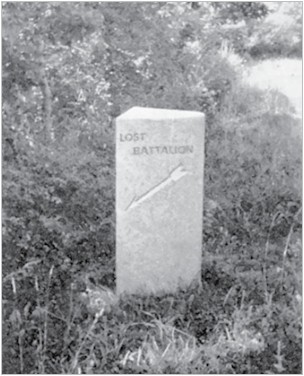
Face to the right, which direction is approximately south.
This point is in the Argonne Forest. One of the most heroic defenses of the war was made on the steep bank just below where the tourist is now standing.
On October 1 the 77th Division was stopped by a strongly organized German defensive line about ½ mile in front of here and the French troops were held up to the right of here, about ¾ mile northwest of the road junction at which the monument to the French 9th Cuirassier Regiment was recently pointed out.
On the morning of October 2, the 77th Division launched an attack all along its front in an attempt, which proved unsuccessful, to capture the ridge back of here. About noon one of its brigades ordered a second attack with this road as its objective. In that attack the units were directed to push forward without regard to the progress of adjoining units, as it had been erroneously reported that the French had made a deep advance north of Binarville and it was believed that the German resistance in front of here was weakening. During the course of this brigade attack, six companies of the 308th Infantry and parts of two companies of the 306th Machine Gun Battalion made a deep advance through an unoccupied portion of the hostile line, the German troops having moved over to repel French attacks on their right. This small American force, meeting little opposition, came into this valley through the ravine, to the right of here, recently pointed out, and about 6:00 p. m. took up a position, which extended from this vicinity about 350 yards to the left, on the slope below the road. This position was immediately organized for all around defense and attempts were made to secure liaison with adjoining troops.
During early evening a battalion of the 307th Infantry attempted to join the force here, but in the darkness the companies lost contact and only one, the leading company, succeeded in advancing through the hostile wire. It took up a position about 300 yards from here to the right front on the near slope of the hill across the valley, where it remained during the night of October 2 in close communication with the troops on this side.
During the night the enemy troops closed the gap in their line and cut off the American force in this vicinity.
On October 3 all efforts of the 77th Division to relieve its so-called “Lost Battalion” failed. Early that morning the company across the valley moved to this side and took up a position on the left of the force here. Shortly thereafter one company was sent to clear a way back up the ravine which had been followed in reaching this spot. It ran into heavy hostile fire and returned, reporting the gap closed. Shortly thereafter another company crossed the valley to the left of here in an attempt to secure contact with the remainder of its division. This unit was attacked on both flanks with such energy that only with great difficulty was it able to return. That marked the last attempt of the troops here to fight their way back to the lines of their division.
The position organized by the “Lost Battalion” on the steep slope below here was in the form of an elongated oval more than 350 yards in length, with an average width of about 75 yards. The machine gun companies were placed on the flanks. The position had one great advantage in that this slope was so steep that German artillery, located in rear of the observer was unable to fire on the men who occupied it. The force dug in and prepared as best it could to withstand a siege.
During October 3 and 4 homing pigeons were used to send six messages back to division headquarters, giving by map coordinates the exact location of the force and describing its critical situation.
In the meantime, the enemy had completely surrounded the “Lost Battalion.” The Germans on the hills to the left and front greeted every movement with rifle fire while heavy machine guns emplaced on the hill to the right front delivered plunging bursts that swept the full length of the American position. Trench mortars, located to the right beyond the mill, and to the rear of the observer, added their fire to the deluge of projectiles which was being poured on the position of this beleaguered force.
The food available was equal to but one day’s supply for four companies and that was consumed by noon of October 3. There was no medical officer, and medical supplies were scarce. As the starving troops were prevented from getting adequate supplies of water by the intense machine-gun fire sweeping the valley, their condition soon became serious.
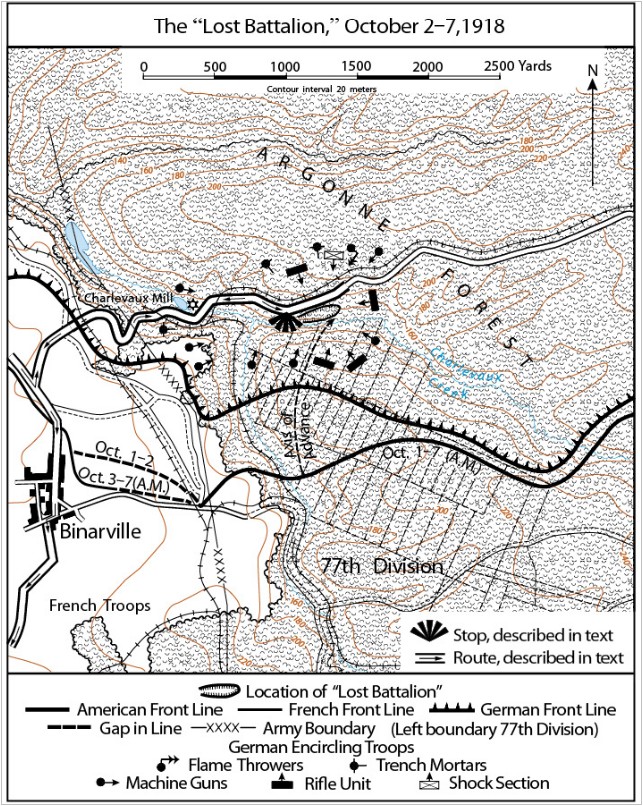
Airplanes were dispatched with messages and food, but such as were dropped fell each time out of reach. During one of these attempts, Second Lieutenant Harold Ernest Goettler, Air Service, and his observer, Second Lieutenant Erwin R. Bleckley, Field Artillery, were brought down by hostile machine-gun fire from the ground. They were posthumously awarded Congressional Medals of Honor.
For the next four days the 77th Division tried unsuccessfully to break through to its isolated force, which in the meantime was performing prodigies of valor in withstanding the German attacks which were launched against it daily.
On the afternoon of October 7, the Germans sent a captured American soldier to the commander of the “Lost Battalion,” with a message advising him to surrender, and stating that a white flag displayed in the American position would be considered as a sign of his intention to do so. This message was answered only by gathering in the white panels which had been used for signaling American airplanes and which lay on the ground at the foot of this slope.
At the time the message was sent, the Germans were on the point of launching a powerful attack, supported by five flame throwers and additional trench mortars. Failing to receive a reply to their message, the Germans placed a terrific trench-mortar bombardment upon the Americans and sprayed them with liquid fire. However, this brave force, summoning all its strength, rose up from its shelters and counterattacked the Germans, killing the operators of the flame throwers and beating off the attack.
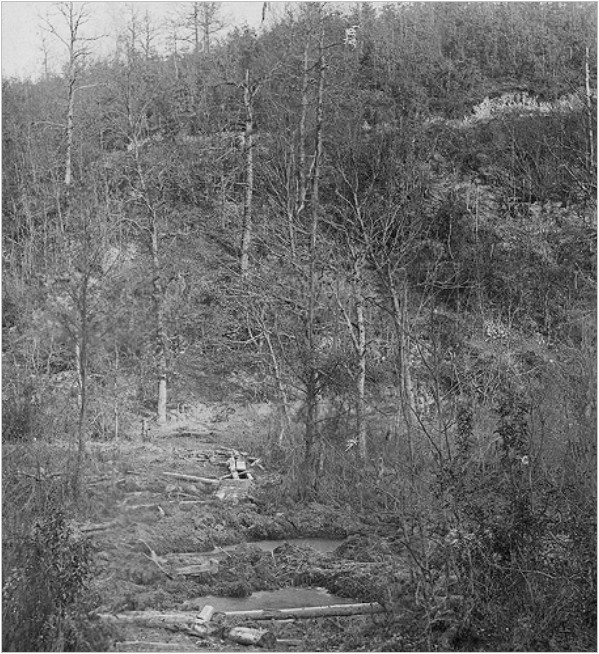
Major Whittlesey displayed marked ability and indomitable spirit in his conduct of the defense, frequently visiting under fire all parts of the position and encouraging the men by his cool demeanor and calm assurance. On the fifth day he received from the Germans a written demand to surrender which he treated with contempt, although at that time his command was out of rations, had suffered a loss of more than 50 per cent and was entirely surrounded by the enemy.
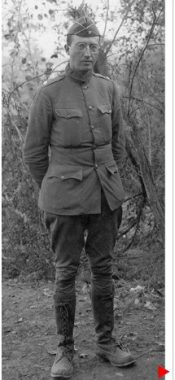
Captain McMurtry commanded a battalion of this force. Although wounded in the knee by shrapnel on October 4 and suffering great pain, he continued throughout the entire period to encourage his officers and men with an irresistible optimism that contributed largely toward preventing panic and disorder among the troops. On October 4, during a heavy barrage, he personally directed and supervised the moving of the wounded to a protected place before himself seeking shelter. On October 6 he was again wounded in the shoulder by a German grenade, but continued personally to organize and direct the defense against the German attack until it was defeated. After assistance had arrived, he refused relief and personally led his men out of the position on October 8 before permitting himself to be evacuated to the hospital.
Captain Holderman commanded one of the companies. He was wounded on October 4, on October 5 and again on October 7, but throughout the entire period, although suffering great pain and subjected to fire of every description, he continued personally to lead and encourage the officers and men under his command with unflinching courage and with distinguished success. On October 6, in a wounded condition, he rushed through enemy machine-gun and shell fire and carried two wounded men to a place of greater safety.
The individual rifle pits used by the men of the “Lost Battalion” can be seen (1937) by climbing about 30 feet down the steep slope leading from the road.
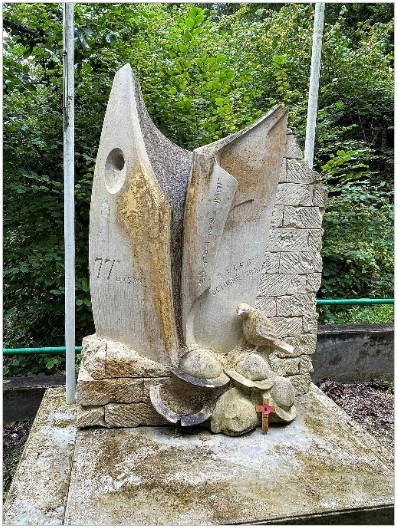
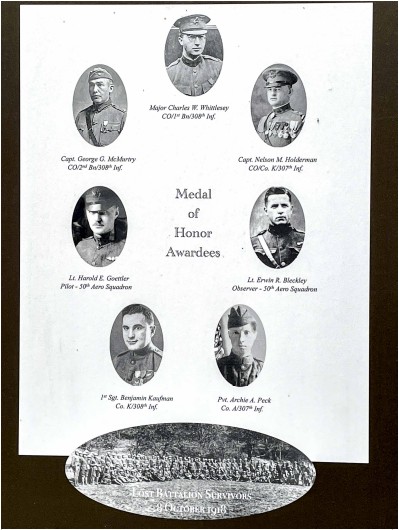
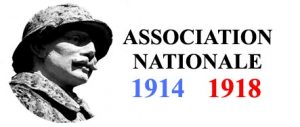
0 commentaire Laisser un commentaire
Les commentaires sont fermés.